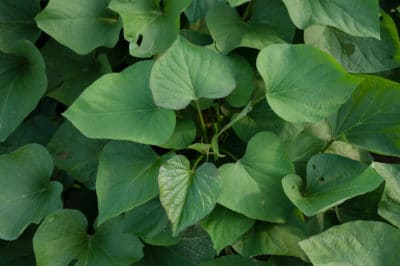About Sweet Potatoes
The sweet potato is a perennial vine, native to the tropics. In developing countries it is a major food source. It is related to the morning glory, and has similar flowers, although it doesn’t usually bloom in temperate climates. The tubers are produced in a cluster underground. A well-grown sweet potato vine will usually produce a pound or more of tubers.
Climates for Sweet Potatoes
Sweet potatoes – even the short-season varieties – need a frost-free growing season of at least 120 days. They do best in USDA Zones 8 to 11. However, they can be grown in the winter in hotter desert climates if given adequate water. In colder zones, they can be started indoors and planted after the risk of frost has passed; they may need to be harvested early, which may limit tuber size.
Growing Sweet Potatoes
Sweet potatoes are not difficult to grow. The rooted sprouts, or slips, should be spaced about 18 inches apart in loose soil that drains well. Moderate fertility is all that’s required, but the plants prefer an acid soil. Most sweet potatoes will produce a crop even in relatively poor soil. Adequate water will increase tuber size and number, although plants can tolerate some dry spells.
Growing Leaves Indoors
You can grow sweet potatoes indoors all year round if you want an edible houseplant. Start the leaves by growing a sweet potato tuber in water, then detach the rooted slips and place each in a clean jar. The vines need no other food, just an occasional water change. You can harvest leaves at any time or harvest the entire vine.
The Shape of the Leaf
Sweet potato leaves come in different shapes, depending on the variety. Leaves grow in a spiral around the stem. Leaves may be lobed or nearly divided and may have smooth or serrated edges. Leaves are slightly hairy to touch. They may be:
- Cordate – shaped like a heart
- Hastate – shaped like a spear
- Reniform or kidney-shaped
- Rounded
- Triangular.
Sweet Potato Leaf Color
Sweet potatoes can be grown primarily for their tubers or for their ornamental leaves. Plants grown for food generally have greenish-yellow or green leaves, and some have purple pigmentation. A few have purple leaves when young and green mature leaves. Ornamental plants may have deep purple to almost black leaves, lime green or yellow leaves and leaves speckled and streaked in different colors, including pink and white.
Leaves are Edible
Many people don’t realize that sweet potato leaves and stems are edible. However, stems – especially those of any size – tend to be tough. The leaves are best if harvested when young and tender. They are usually cooked in water as you would chard or spinach. They can also be sliced thin and added to salads or sauteed in fat or broth.
Nutrients in Leaves
Sweet potatoes can be compared to spinach in terms of nutrients. They are high in calcium, iron and zinc. Sweet potatoes are also a good source of carotene. The leaves contain the vitamins C, E and K, as well as riboflavin, thiamine, folic acid and niacin. Like spinach, they do contain oxalic acid, but in much lower quantities, which is why they can be used raw as well as cooked.
Recipes for Leaves
Sweet potato leaves can be substituted for other leafy greens. Try them sauteed in a little olive oil or butter with some onions. Cook them in boiling water until just wilted, then cover in a sauce such as hollandaise. Chopped leaves can be added to soups, stews and casseroles. Finely sliced leaves are a good addition to salads or can be made into vegetable fritters.
Storing Sweet Potato Leaves
The two best methods of preserving sweet potato leaves are freezing and dehydrating. In both cases, the leaves should be blanched and then shocked in ice water. Shake off any water remaining on the leaves, then freeze or dehydrate. Although it’s possible to pressure can them just as you would spinach, the taste and texture are not as good as when frozen.
